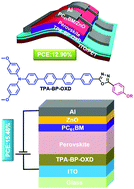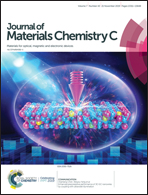A linear D–π–A based hole transport material for high performance rigid and flexible planar organic–inorganic hybrid perovskite solar cells†
Abstract
A facile and less expensive hole transport material is essential to enhance the power conversion efficiency (PCE) of perovskite solar cells (PSC) without compromising the ambient stability. Here, we designed and synthesized a new class of HTM by introducing donor–π–acceptor (D–π–A). The HTM was synthesized by combining the moieties of triphenylamine, biphenyl and oxadiazole derivatives as electron donating, π-spacer and electron withdrawing moieties, respectively, named 4′′′-(5-(4-(hexyloxy)phenyl)-1,3,4-oxadiazol-2-yl)-N,N-bis(4-methoxyphenyl)-[1,1′:4′,1′′:4′′,1′′′-quaterphenyl]-4-amine (TPA-BP-OXD). The π–π conjugation is increased by introducing the biphenyl π-spacer. The HTM was terminated with an OXD-based moiety and framed as a D–π–A-based HTM that trigged improvement in the charge transportation properties due to its π–π interactions. We rationally investigated the HTM by characterizing its photophysical, thermal, electrochemical, and charge transport properties. The great features of the HTM stimulated us to explore it on rigid and flexible substrates as a dopant-free HTM in planar inverted-perovskite solar cells (i-PSCs). The device performance in solution processed dopant-free HTM based i-PSC devices on both rigid and flexible substrates showed PCEs of 15.46% and 12.90%, respectively. The hysteresis is negligible, which is one of the most effective results based on a TPA-BP-OXD HTM in planar i-PSCs. The device performance and stability based on the TPA-BP-OXD HTM are better due to higher extraction and transportation of holes from the perovskite material, reduced charge recombination at the interface, and enhanced hydrophobicity of the HTM to compete for a role in enhancing the stability. Overall, our findings demonstrate the potentiality of the TPA-BP-OXD based HTM in planar i-PSCs.



 Please wait while we load your content...
Please wait while we load your content...